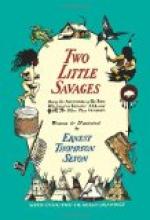“Then the other Injuns made their claims, an’ we all got some kind of honours. I mind one feller was allowed to drag a Fox tail at each heel when he danced, an’ another had ten horseshoe marks on an Eagle feather for stealing ten horses, an’ I tell you them Injuns were prouder of them feathers than a general would be of his medals.”
[Illustration: The War Bonnet (See description below)]
THE INDIAN WAR BONNET—HOW TO MAKE IT
1. The plain white Goose or Turkey feather.
2. The same, with tip dyed black or painted with indelible ink.
3. The same, showing ruff of white down lashed on with wax end.
4. The same, showing leather loop lashed on for the holding lace.
5. The same, viewed edge on.
6. The same, with a red
flannel cover sewn and lashed on the
quill. This is a ‘coup
feather.’
7. The same, with a tuft of red horsehair lashed on the top to mark a ‘grand coup’ and (a) a thread through the middle of the rib to hold feather in proper place. This feather is marked with the symbol of a grand coup in target shooting. This symbol may be drawn on an oval piece of paper gummed on the top of the feather.
8. The tip of a feather
showing how the red horsehair tuft is
lashed on with fine waxed
thread.
9. The groundwork of the war bonnet made of any soft leather, (a) a broad band to go round the head, laced at the joint or seam behind; (b) a broad tail behind as long as needed to hold all the wearer’s feathers; (c) two leather thongs or straps over the top; (d) leather string to tie under the chin; (e) the buttons, conchas or side ornaments of shells, silver, horn or wooden discs, even small mirrors and circles of beadwork were used, and sometimes the conchas were left out altogether; they may have the owner’s totem on them, usually a bunch of ermine tails hung from each side of the bonnet just below the concha. A bunch of horsehair will answer as well; (hh) the holes in the leather for holding the lace of the feather; 24 feathers are needed for the full bonnet, without the tail, so they are put less than an inch apart; (iii) the lacing holes on the tail: this is as long as the wearer’s feathers call for; some never have any tail.
10. Side view of the
leather framework, showing a pattern
sometimes used to decorate
the front.
11, 12 and 13. Beadwork designs for front band of bonnet; all have white grounds. No. 11 (Arapaho) has green band at top and bottom with red zigzag. No. 12 (Ogallala) has blue band at top and bottom, red triangles; the concha is blue with three white bars and is cut off from the band by a red bar. No. 13 (Sioux) has narrow band above and broad band below blue, the triangle red, and the two little stars blue with yellow centre.
14. The bases of three
feathers, showing how the lace comes out
of the cap leather, through
the eye or loop on the bottom of the
quill, and in again.




